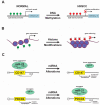Epigenetic Modifications and Head and Neck Cancer: Implications for Tumor Progression and Resistance to Therapy
- PMID: 28704968
- PMCID: PMC5535996
- DOI: 10.3390/ijms18071506
Epigenetic Modifications and Head and Neck Cancer: Implications for Tumor Progression and Resistance to Therapy
Abstract
Head and neck squamous carcinoma (HNSCC) is the sixth most prevalent cancer and one of the most aggressive malignancies worldwide. Despite continuous efforts to identify molecular markers for early detection, and to develop efficient treatments, the overall survival and prognosis of HNSCC patients remain poor. Accumulated scientific evidences suggest that epigenetic alterations, including DNA methylation, histone covalent modifications, chromatin remodeling and non-coding RNAs, are frequently involved in oral carcinogenesis, tumor progression, and resistance to therapy. Epigenetic alterations occur in an unsystematic manner or as part of the aberrant transcriptional machinery, which promotes selective advantage to the tumor cells. Epigenetic modifications also contribute to cellular plasticity during tumor progression and to the formation of cancer stem cells (CSCs), a small subset of tumor cells with self-renewal ability. CSCs are involved in the development of intrinsic or acquired therapy resistance, and tumor recurrences or relapse. Therefore, the understanding and characterization of epigenetic modifications associated with head and neck carcinogenesis, and the prospective identification of epigenetic markers associated with CSCs, hold the promise for novel therapeutic strategies to fight tumors. In this review, we focus on the current knowledge on epigenetic modifications observed in HNSCC and emerging Epi-drugs capable of sensitizing HNSCC to therapy.
Keywords: DNA methylation; HNSCC (Head and Neck Squamous Cell Carcinoma); acetylation; cancer stem cell; chemoresistance; epigenetics; histone H3; histone modifications; microRNA.
Conflict of interest statement
The authors declare no conflict of interest.
Figures


Similar articles
-
Epigenetic Modifications in Head and Neck Cancer.Biochem Genet. 2020 Apr;58(2):213-244. doi: 10.1007/s10528-019-09941-1. Epub 2019 Nov 11. Biochem Genet. 2020. PMID: 31712935 Free PMC article. Review.
-
Activation of Matrix Hyaluronan-Mediated CD44 Signaling, Epigenetic Regulation and Chemoresistance in Head and Neck Cancer Stem Cells.Int J Mol Sci. 2017 Aug 24;18(9):1849. doi: 10.3390/ijms18091849. Int J Mol Sci. 2017. PMID: 28837080 Free PMC article. Review.
-
Harnessing the role of epigenetic histone modification in targeting head and neck squamous cell carcinoma.Epigenomics. 2022 Mar;14(5):279-293. doi: 10.2217/epi-2020-0348. Epub 2022 Feb 21. Epigenomics. 2022. PMID: 35184601 Review.
-
Histone modifications: Targeting head and neck cancer stem cells.World J Stem Cells. 2014 Nov 26;6(5):511-25. doi: 10.4252/wjsc.v6.i5.511. World J Stem Cells. 2014. PMID: 25426249 Free PMC article. Review.
-
Targeting Epigenetic Dysregulations in Head and Neck Squamous Cell Carcinoma.J Dent Res. 2025 Mar;104(3):225-234. doi: 10.1177/00220345241297122. Epub 2024 Dec 19. J Dent Res. 2025. PMID: 39698794 Review.
Cited by
-
Advances in the Histone Acetylation Modification in the Oral Squamous Cell Carcinoma.J Oncol. 2023 Feb 9;2023:4616682. doi: 10.1155/2023/4616682. eCollection 2023. J Oncol. 2023. PMID: 39282225 Free PMC article. Review.
-
Interfering with bromodomain epigenome readers as therapeutic option in mucoepidermoid carcinoma.Cell Oncol (Dordr). 2019 Apr;42(2):143-155. doi: 10.1007/s13402-018-0416-2. Epub 2018 Dec 11. Cell Oncol (Dordr). 2019. PMID: 30539410
-
Genome-Wide Enhancer Analysis Reveals the Role of AP-1 Transcription Factor in Head and Neck Squamous Cell Carcinoma.Front Mol Biosci. 2021 Aug 2;8:701531. doi: 10.3389/fmolb.2021.701531. eCollection 2021. Front Mol Biosci. 2021. PMID: 34409068 Free PMC article.
-
High Risk-Human Papillomavirus in HNSCC: Present and Future Challenges for Epigenetic Therapies.Int J Mol Sci. 2022 Mar 23;23(7):3483. doi: 10.3390/ijms23073483. Int J Mol Sci. 2022. PMID: 35408843 Free PMC article. Review.
-
Role of epigenetics in OSCC: an understanding above genetics.Med Oncol. 2023 Mar 20;40(4):122. doi: 10.1007/s12032-023-01992-0. Med Oncol. 2023. PMID: 36941511 Review.
References
-
- Papillon-Cavanagh S., Lu C., Gayden T., Mikael L.G., Bechet D., Karamboulas C., Ailles L., Karamchandani J., Marchione D.M., Garcia B.A., et al. Impaired H3K36 methylation defines a subset of head and neck squamous cell carcinomas. Nat. Genet. 2017;49:180–185. doi: 10.1038/ng.3757. - DOI - PMC - PubMed
Publication types
MeSH terms
Substances
LinkOut - more resources
Full Text Sources
Other Literature Sources

